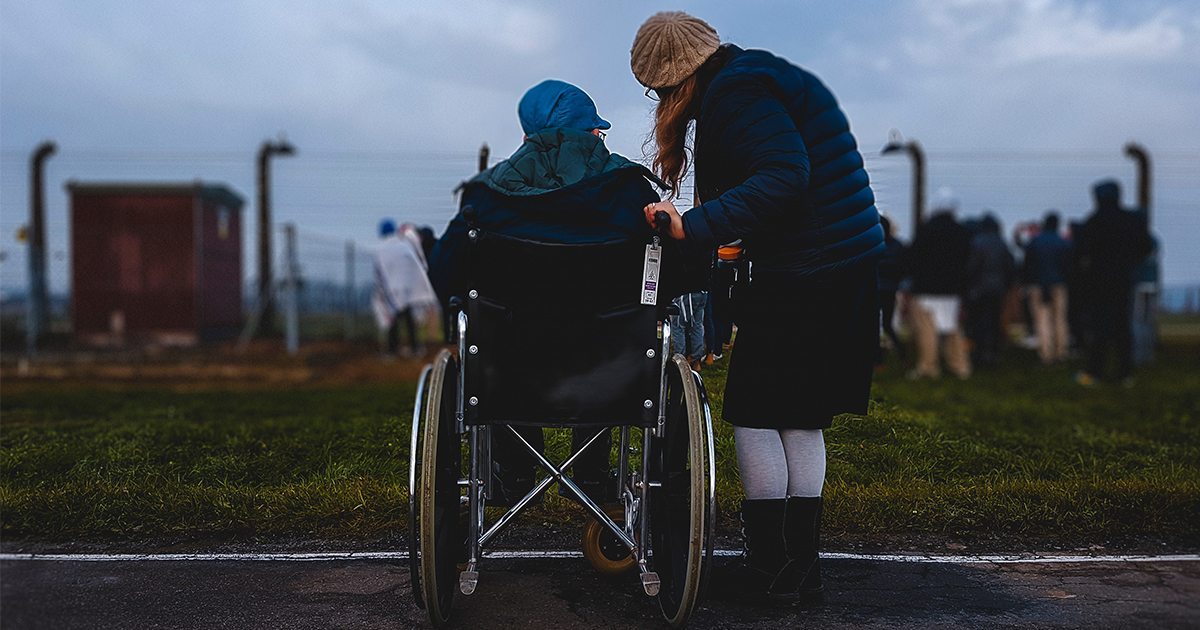Month: August 2015
Advocacy for the Mesothelioma Community May Evolve Over Time
Unfortunately, there are countless members of the mesothelioma community, and our numbers are growing by the day. Each one of us advocates for those affected by this disease in our own way. Some take a more “in your face” approach, some quietly talk to their family and friends, and still others are somewhere in between. No matter where you find yourself, your efforts are appreciated.
For my family, a lot of the level of involvement that we had at any particular time, depended on where Dad was in his treatment process and his overall health. As much as we wanted to be “all in” all of the time, it just wasn’t possible. Our number one priority had to be taking care of my father, while praying for those who were able to be more active at that point.
Emotions can play a big role in someone’s level of involvement and willingness to share their story. For example, when we were grieving my Dad’s loss, I sort of stayed on the outskirts of things for a bit. The feelings of sadness and pain were too raw and I needed some time to sort through everything before I felt ready to dive back in. For others, these feelings may be a catalyst to act and act now. Everyone is different and will respond in the way they feel best for them.
It’s ok to choose your own way to advocate. Even our silent members are an important part of this community. We all have a shared bond that we wish we didn’t, but we have helped each other through the awful highs and lows that are part and parcel with this cancer. We all have our own story to share in whichever way we choose.

Study Shows That Asbestos Risks Remain Decades After Industry Departs
An Italian study published back in May found that malignant mesothelioma cases tend to be concentrated around industrial facilities that use asbestos. A new Italian study finds that mesothelioma incidence near industrial areas remains high long after an asbestos-using industry ceases operations.
Asbestos is the only known cause of mesothelioma, an incurable cancer affecting the membranous lining of the lungs and abdomen. Most cases of mesothelioma are related to occupational asbestos exposure. Cement factories, shipyards, automotive plants, food processing facilities, power plants, and steel plants are among the major sources of occupational asbestos exposure.
Not all asbestos exposure, however, is directly attributable to a person’s work activities. People can also be environmentally exposed to asbestos in areas where asbestos industries operate.
One such area is Casale Monferrato in Northwest Italy, the former home of the Eternit asbestos-cement plant, which closed in 1986. An Italian court in 2012 convicted the plant’s owners of causing the asbestos-related deaths of more than 3,000 people. While many of those people worked at the Eternit plant, others merely lived near the plant.
Casale Montferro is the subject of a study published recently in Occupational & Environmental Medicine. The study authors identified 200 cases of pleural mesothelioma diagnosed in Casale Montferro residents between 2001 and 2006 in an effort to quantify the association between pleural mesothelioma and asbestos exposure.
They discovered that the odds ratio (OR, a measure of association between an exposure and an outcome) of an asbestos-exposed individual developing mesothelioma ranged from 4.4 to 62.1, with increased exposure over time resulting in a higher OR. Subjects never occupationally exposed to asbestos had a mesothelioma OR of 3.8 to 23.3, while an OR of around 2 was observed for people living in homes near buildings with large asbestos cement parts.
The findings draw attention to the fact that asbestos health risks linger in the environment long after asbestos industries vacate. In addition, they serve as a reminder that asbestos disease can occur in people who never directly handled asbestos on the job.
“Risk of [pleural malignant mesothelioma] increased with cumulative asbestos exposure and also in analyses limited to subjects non-occupationally exposed. Our results also provide indication of risk associated with common sources of environmental exposure and are highly relevant for the evaluation of residual risk after the cessation of asbestos industrial use,” write the study authors.
The Italian study has implications for America and other countries with a history of industrial asbestos use. U.S. asbestos use peaked in the mid-70s, but asbestos diseases, which have a latency period of 10-40 years or more, continue to kill an estimated 12,000-15,000 Americans.
But the United States, unlike Italy, has not banned asbestos. While both countries deal with the residual presence of asbestos-containing materials from a bygone industrial era, the United States is unique among industrialized nation for its ongoing importation and use of asbestos.
Anyone interested in taking part in the fight against asbestos should visit the EWG Action Fund website.
The Inconvenience of Mesothelioma
It was a Sunday afternoon. My husband and I had just gotten to my parent’s house and were planning to go to the hospital with them the next morning for Dad’s procedure. They were going to go in, find out what was causing the fluid in his lungs, fix it or come up with a treatment plan. He was going to be in the hospital a couple of days, come home, and be fine. Mike and I were going to leave for home on Wednesday and participate in a home show on Thursday. Everything was supposed to be fine.
The procedure was over and the surgeon took me and my family into a private room. I looked at Mike and said, “This isn’t good.” The doctor gently delivered the news that would forever change our lives. “It looks like a mesothelioma.” At the time, I didn’t understand what that meant, but once the reality sunk in, I began crying and shaking uncontrollably. As I peered around the room and saw the looks in everyone’s eyes, I knew that this battle had just begun and that everything was going to be different from here on out.
Mesothelioma began its reign over our lives. Every waking moment and the majority of my dreams were consumed by it. I thank God that we had some truly miraculous moments during our journey with this awful cancer, but it was still always at the fronts of our minds.
When Dad lost his battle to the disease on October 15, 2013, he was freed of mesothelioma; those of us left behind were not. The remnants of mesothelioma are seen in my family and me every single day. There is always a bit of sadness, missing Dad and wishing he were here for every moment. There is an empty place at the table, an empty rocking chair, and an emptiness in every conversation where his laugh should be interjected.
Mesothelioma is so many things. One thing it is for sure is an inconvenience… not necessarily in the traditional sense of the word, but in a harsher way. Our lives were changed and impacted in ways we could never have prepared ourselves for. This disease is a game changer, and not for the better.

Mesothelioma Nurse Explains The Need for a Caregiving Team
Having mesothelioma can be devastating and overwhelming. It makes your mind and your loved ones’ minds spin. There are a thousand questions you have, both answered and unanswered. I have answered many of these questions, but over the years I have asked my share of questions as well. One of the most important things I have learned from the patients and their families, is that a strong care team is vital to recovery.
I have watched each case, and I have noted what seems to work and what doesn’t always work. I would say that having a strong support system is definitely key to easing the stress of the mesothelioma patient. You should not only designate a primary caregiver, but you should also select other friends and family members who can serve as backup.
You may think that you and your significant other can handle what comes along with mesothelioma, but that is not always the case. Things can go wrong, or at least not work out exactly how you figured they would. It happens more times than not. If possible, you should have people around you who are committed to helping you with all of your loved one’s healthcare needs.
Who can be there for you at the drop of a hat if you need a ride to a chemotherapy appointment, or if you need to see a doctor when you are not feeling well? In the best possible situation, you could have three to four people who have a flexible schedule and are able to commit to being available with little notice.
Recently a middle-aged patient and his wife came in for treatment. Unfortunately, things have not gone according to plan. The patient’s stay in the hospital has been extended, and feels like forever to his wife. This unexpected development has left her frightened, alone, and far from any other support system that she has. Her reactions have taken a toll on her husband’s emotional well being, and have challenged the medical professions who are caring for him.
Her fear and frustration have become crippling to her. She is the primary support for her husband, but she has little, if any, support for herself.
It is ok to be the caregiver and to acknowledge the need of time for yourself. There are support staff within any large medical institution who can offer you support. They can be helpful and are great sounding boards, are non-judgmental and they can see your unique situation from a different perspective.
After a rough few days the wife agreed to call her sister to come and help her, taking all of the responsibility off her shoulders, and sharing it. A true sign that strength is in numbers!
If you have any questions about any aspect of your mesothelioma care, please email me at [email protected].
Know more about Mesothelioma and how you can deal with it.

Waiting and Praying for a Cure for Mesothelioma
Patience is a virtue; this phrase has been repeated to millions of people, millions of times, for millions of different reasons. For mesothelioma patients, their families and loved ones, the waiting is often the hardest part.
There is a lot of waiting involved in a battle with mesothelioma. You wait for test results, you wait in doctor’s offices, you wait to feel some relief, you wait for a new treatment option. Ultimately, you wait for a cure.
I spent many hours agonizing over what my Dad’s scans would show. I wanted to know if things were clear; I needed to see that nothing had come back. But once the doctor would walk into the room, I wondered if I would rather hear the results or continue waiting.
The time spent waiting for appointments is trying. You understand that there are other patients who need care, but couple the waiting with anxiety and the result is awful! When Dad would be having a hard day, I would wait for him to feel better. When he was doing well, I would wonder if he would have to experience any more illness. The emotional rollercoaster is never-ending.
Waiting for new treatments and a mesothelioma cure is hard. You pray for it every single day, hoping that the next option will be the one that can eradicate this disease once and for all. Please continue to pray for this. It would be wonderful if all of this waiting could end, and we could all start looking forward to a brighter future, free of mesothelioma forever.

Free Mesothelioma Patient & Treatment Guide
We’d like to offer you our in-depth guide, “A Patient’s Guide to Mesothelioma,” absolutely free of charge.
It contains a wealth of information and resources to help you better understand the condition, choose (and afford) appropriate treatment, and exercise your legal right to compensation.
Download Now